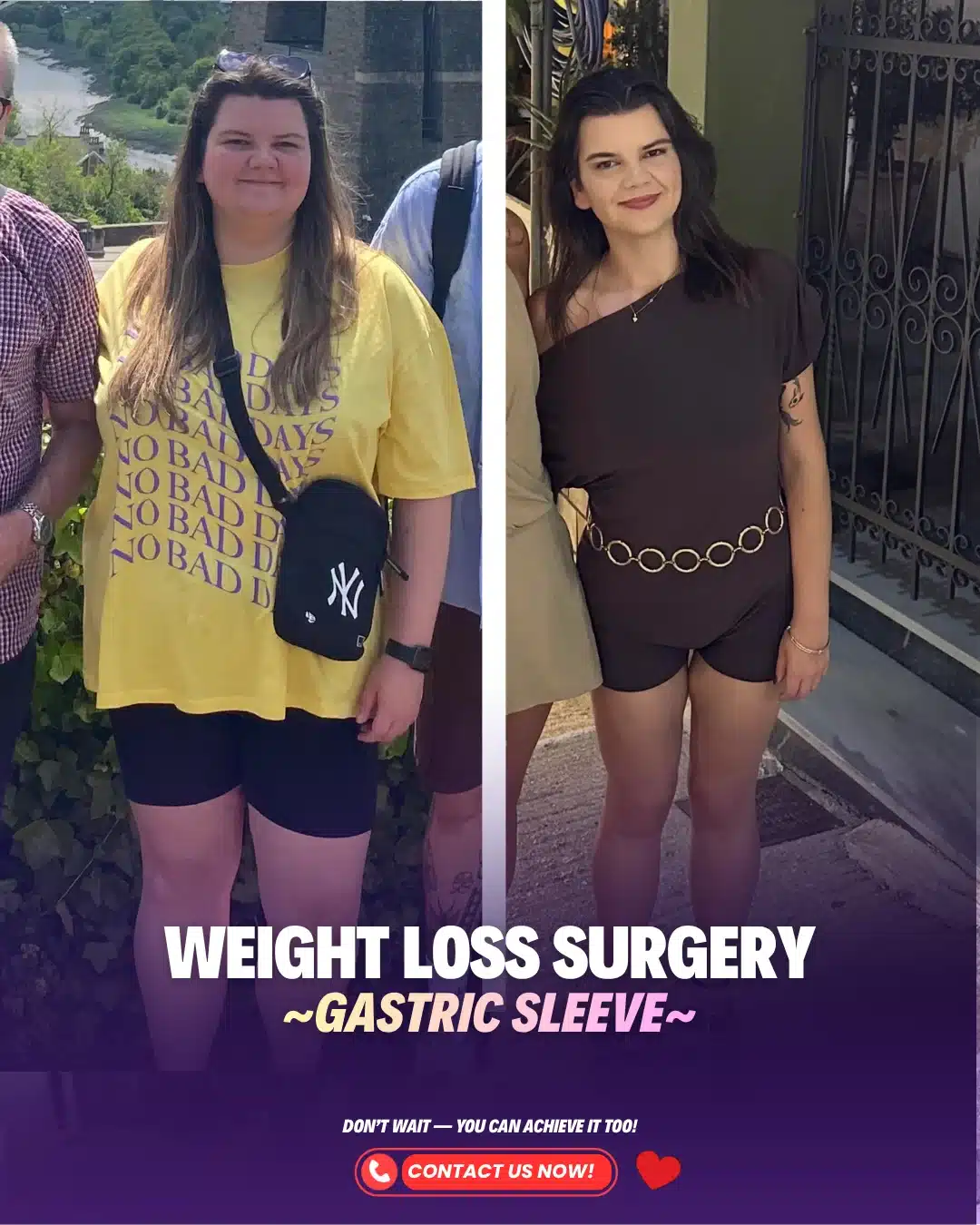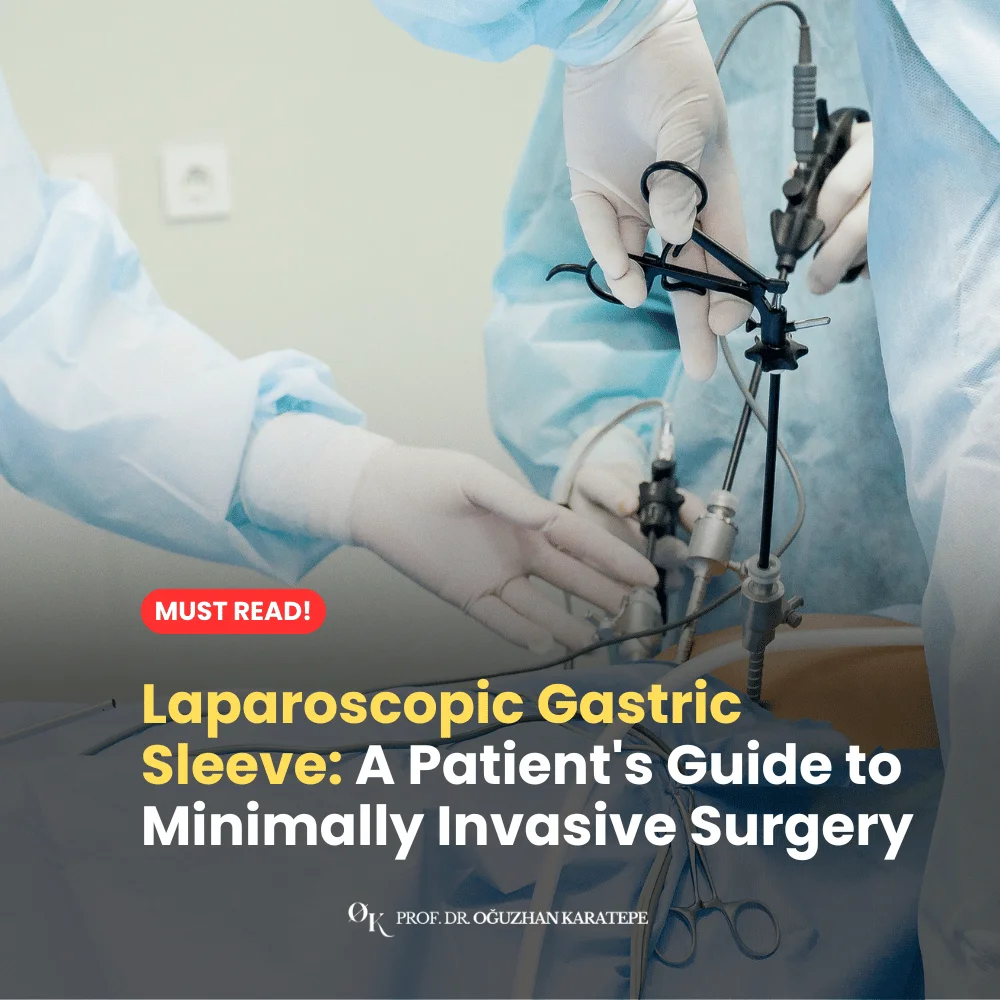Laparoscopic Gastric Sleeve: A Patient’s Guide to Minimally Invasive Surgery
Welcome to our educational guide on laparoscopic gastric sleeve surgery. If you are researching weight loss surgery options, you have almost certainly come across this term. It is important to understand that “laparoscopic” is not a *type* of gastric sleeve, but rather the *modern surgical technique* used to perform it. It is the gold standard for star-surgery, and it is the reason this procedure is so safe and has such a fast recovery time.
This page is designed to be a clear, factual, and simple resource. We will explain what “laparoscopic” means, what happens during the procedure, and what the benefits are for you. As a leading bariatric surgery team with decades of experience, our expert team is here to help you understand every step of the process. We provide personalized surgical solutions built on a foundation of safety and advanced technology.
Free WhatsApp Consultation:
Contact us now! 👉 +90 530 489 94 74
Our patıents
Meet Some of Our Patients Who Underwent Gastric Sleeve Surgery



What Is Laparoscopic Gastric Sleeve Surgery?
A laparoscopic gastric sleeve is a minimally invasive surgery, also known as “keyhole surgery.” This is the complete opposite of traditional “open” surgery, where a surgeon would make one very large 6 to 10-inch incision (cut) to open the abdomen and work on the stomach. The laparoscopic technique is far more advanced and patient-friendly.
Here is what happens during a laparoscopic gastric sleeve procedure:
- Anaesthesia: You will be given general anaesthesia, so you will be safely asleep and will not feel anything during the operation.
- Small Incisions: Your surgeon, Prof. Dr. Oguzhan Karatepe, will make 3 to 5 very small incisions in your abdomen. These “keyholes” are typically only 1-1.5 cm (about half an inch) long.
- The Laparoscope: A tiny, high-definition camera (the “laparoscope”) is inserted into one of these incisions. This camera projects a magnified, 3D view of the inside of your body onto a set of high-definition monitors in the operating room.
- The Procedure: Your surgeon inserts long, thin, specialized surgical tools through the other small incisions. Watching the monitors, they use these tools to perform the stomach reduction surgery. They will carefully separate and remove about 75-80% of the stomach, stapling the new, smaller “sleeve” shut.
This advanced technique is the standard of care for bariatric surgery because it is just as effective as open surgery but is dramatically safer and easier on the patient’s body. It requires a high level of specialized training and experience, which is why your choice of surgeon is so important.
How is laparoscopic surgery different from open surgery?
Open surgery involves one very large incision (cut) to open the abdomen, resulting in more pain, a longer hospital stay, and a large scar. Laparoscopic surgery is a “keyhole” technique that uses 3-5 tiny incisions, a small camera, and specialized tools. This method is far less traumatic, resulting in minimal scarring and a much faster recovery.
Free WhatsApp Consultation:
Contact us now! 👉 +90 530 489 94 74
The Key Benefits of the Laparoscopic Technique
Choosing a surgeon who is an expert in laparoscopic gastric sleeve surgery is critical because this technique is directly linked to your safety and recovery. The benefits of a minimally invasive approach over an old-fashioned open surgery are significant.
1. Less Post-Operative Pain
Because the surgeon is not making a large cut through your sensitive abdominal muscles, post-operative pain is significantly reduced. Most patients do not describe “pain” but rather a “soreness,” as if they did a very intense ab workout. This soreness is well-managed with medication, and you will be encouraged to get up and walk on the same day as your surgery.
2. Faster Recovery Time
This is one of the biggest benefits. The gastric sleeve recovery time is much faster with a laparoscopic approach.
- Hospital Stay: You will typically stay in the hospital for only 2-3 nights, not a week or more.
- Returning to Work: Most patients with a desk job can return to work within 2 to 3 weeks. Those with more physically demanding jobs may need 4-6 weeks.
3. Minimal Scarring
This is a major cosmetic benefit. Instead of one large, very noticeable scar across your abdomen, you will have 3-5 small gastric sleeve scars. These tiny lines heal very well and, for most patients, fade significantly over a year until they are barely noticeable. One incision will be slightly larger (about 1.5-2 cm) so the portion of the stomach can be removed, but it is still very small.
4. Lower Risk of Complications
Smaller incisions mean a lower risk of wound-related gastric sleeve complications. This includes:
- A significantly reduced risk of infection at the incision sites.
- A much lower risk of developing an incisional hernia (a bulge where the incision was made).
- Less internal scarring (adhesions) inside the abdomen.
How long is recovery from a laparoscopic gastric sleeve?
The initial gastric sleeve recovery time is fast. Most patients stay in the hospital for 2-3 nights. You can return to a desk job and light activities in 2 to 4 weeks. Full recovery, which includes being cleared for heavy lifting or strenuous exercise, typically takes about 4-6 weeks.
Free WhatsApp Consultation:
Contact us now! 👉 +90 530 489 94 74

Why Choose Prof. Dr. Oguzhan Karatepe for Your Laparoscopic Gastric Sleeve?
Laparoscopic surgery is not a “plug-and-play” technology; it is a high-level skill that is refined over thousands of procedures. Your safety and outcome are directly related to the experience and precision of your surgeon. Prof. Dr. Oguzhan Karatepe is a leading figure in bariatric surgery, bringing over 25 years of specialized experience to every patient.
With more than 3,000 successful surgeries performed and hundreds of academic publications, his expertise is not just clinical; it is academic. As a Professor of Surgery, he is a true authority in his field. He is a master of A-A-techniques, which are the most advanced forms of minimally invasive surgery.
This level of expertise is critical for a laparoscopic gastric sleeve. It ensures:
- Maximum Precision: A surgeon with this much experience can create a perfectly shaped “sleeve” and a secure staple line, which is the most important factor in preventing gastric sleeve complications like leaks.
- Efficiency & Safety: A high-volume surgeon works more efficiently, meaning less time under anaesthesia for you. They have seen and managed every possible variation in patient anatomy.
- Expertise in Advanced Cases: Prof. Dr. Karatepe’s experience includes complex cases, such as gastric sleeve revision surgery, which requires the highest level of laparoscopic skill.
Our expert team is here to help you, and our commitment is to provide a personalized surgical solution using the most advanced, safest techniques available.
How to choose the right gastric sleeve surgeon?
Gastric sleeve surgery is performed by a bariatric surgeon (a general surgeon with specialized fellowship training). When choosing, look for a surgeon with extensive, verifiable experience (1,000+ procedures) and specific expertise in laparoscopic and robotic surgery. This is a key qualification for a safe, modern procedure.
Frequently Asked Questions (FAQ) About Laparoscopic Gastric Sleeve
Q: What is gastric sleeve surgery?
A: Gastric sleeve surgery is a weight loss operation where a surgeon removes about 75-80% of the stomach. This leaves a small, “sleeve-shaped” stomach, which restricts food intake and reduces hunger hormones, helping you lose weight effectively.
Q: What does “laparoscopic” mean?
A: “Laparoscopic” is a minimally invasive surgical technique. It is also called “keyhole surgery.” It uses a tiny camera and long, thin tools inserted through 3-5 small incisions, avoiding the need for a large, open cut.
Q: How many scars will I have from a laparoscopic gastric sleeve?
A: You will typically have 3 to 5 small gastric sleeve scars. Each incision is about 1-1.5 cm (0.5 inches). These small lines fade significantly over time and are easily hidden.
Q: Is laparoscopic gastric sleeve safer than open surgery?
A: Yes, significantly. The laparoscopic method has a much lower risk of complications like wound infections, hernias, and blood loss. It is the gold standard for bariatric surgery due to its high safety profile.
Q: How long does the laparoscopic gastric sleeve surgery take?
A: The procedure itself is usually very efficient in the hands of an expert. It typically takes about 60 to 90 minutes. You will be in the recovery room for a few hours after that.
Q: What is robotic-assisted laparoscopic surgery?
A: This is an even more advanced form of laparoscopic surgery. The surgeon (like Prof. Dr. Karatepe) sits at a console and controls robotic arms. This system provides a 3D, high-definition view and “wristed” instruments that can move with greater precision than a human hand. It is an excellent tool for complex cases.
Q: Is the recovery from laparoscopic surgery painful?
A: The pain is much less than with open surgery. Most patients describe it as a deep “soreness” in their abdominal muscles. This is well-managed with medication, and you will be up and walking on the same day as your surgery to help your recovery.
Q: When can I go back to work after this surgery?
A: This depends on your job. Most patients with a desk job can return to work in 2 to 3 weeks. If your job is physically demanding and requires heavy lifting, you will need to wait 4-6 weeks.
Q: What are the main risks of laparoscopic surgery?
A: The risks are low but are the same as any gastric sleeve procedure. This includes the risk of bleeding, infection, blood clots, and a staple line leak. Choosing a high-volume, experienced surgeon is the most important way to minimize these risks.
Q: Is everyone a candidate for the laparoscopic technique?
A: Today, almost every patient is a candidate for a laparoscopic gastric sleeve. In extremely rare cases, a patient with a very high Learn what a laparoscopic gastric sleeve is, how this minimally invasive “keyhole” surgery works, and what to expect from recovery, scars, and risks. (e.g., 70+) or massive amounts of scar tissue from previous *open* abdominal surgeries may need a different approach. This is determined during your consultation.
Q: How long will I be in the hospital?
A: Thanks to the gentle, laparoscopic technique, your hospital stay is short. Most patients go home after 2 to 3 nights.
Legal Disclaimer
This information is for general educational purposes only and is not a substitute for professional medical advice. For personalized treatment plans, please contact Prof. Dr. Oguzhan Karatepe directly.
Contact Us Today
Our expert team in gastric sleeve surgery is ready to assist you. If you have more questions about the laparoscopic gastric sleeve technique or wish to schedule a consultation, please reach out to us.
Free WhatsApp Consultation:
Contact us now! 👉 +90 530 489 94 74
How can I book an appointment?
You can contact us directly via phone, WhatsApp, or by filling out the online contact form on our website. Our dedicated patient coordinators will be happy to schedule your free, no-obligation consultation.
